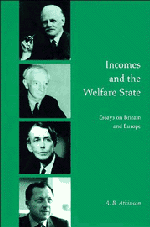Book contents
- Frontmatter
- Contents
- List of figures
- List of tables
- Preface
- Introduction
- I Income inequality and poverty in Britain and Europe
- 1 What is happening to the distribution of income in the UK?
- 2 Income distribution in European countries
- 3 Poverty, statistics and progress in Europe
- 4 Comparing poverty rates internationally: recent studies in OECD countries
- 5 Two nations in early retirement? The case of Britain
- II Analysis of the Welfare State
- III Targeting and the future of social security policy
- Notes
- Bibliography
- Name index
- Subject index
2 - Income distribution in European countries
Published online by Cambridge University Press: 03 May 2011
- Frontmatter
- Contents
- List of figures
- List of tables
- Preface
- Introduction
- I Income inequality and poverty in Britain and Europe
- 1 What is happening to the distribution of income in the UK?
- 2 Income distribution in European countries
- 3 Poverty, statistics and progress in Europe
- 4 Comparing poverty rates internationally: recent studies in OECD countries
- 5 Two nations in early retirement? The case of Britain
- II Analysis of the Welfare State
- III Targeting and the future of social security policy
- Notes
- Bibliography
- Name index
- Subject index
Summary
The aim of this chapter is to assemble empirical evidence about the personal distribution of income, and the trends in income inequality over time, in the countries of Europe in the 1980s. It encompasses 15 European countries: the Nordic countries, Switzerland, and all 12 members of the European community apart from Greece. The United States is included as a point of reference.
Empirical facts are treacherous objects. The subject of income distribution is littered with ‘facts’ that have ceased to hold or which proved on closer examination to be mere statistical artefacts rather than genuine economic regularities (remember Keynes’ constancy of the share of labour?). The value of empirical generalisations has more often been found in the theoretical process used to explain them than in the empirical observation itself. It can be argued that the – very substantial contribution of Kuznets’ Presidential Address (1955) lay in his analytical framework rather than in the celebrated Kuznets curve indicating that inequality first rises and then falls as a country develops. This chapter starts therefore from a position of modesty as to what can be achieved by a summary of the empirical evidence. Not the least of the reasons for this are the difficulties in making such comparisons, and it is with their limitations that the chapter begins in section 2.1.
The second difficulty in writing a chapter on empirical facts is that these have many dimensions. Here we have chosen to concentrate on the comparison of income inequality across countries, and across time.
- Type
- Chapter
- Information
- Incomes and the Welfare StateEssays on Britain and Europe, pp. 41 - 63Publisher: Cambridge University PressPrint publication year: 1996
- 30
- Cited by



